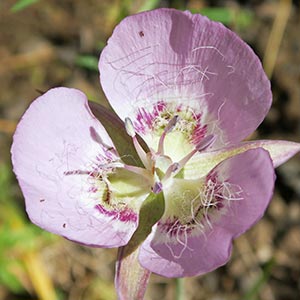Calochortus longebarbatus
Calochortus coxii
long-bearded mariposa lily, long-bearded sego-lily, long-hair star-tulip, longbeard mariposa lily
Cox's cat's ear, Cox's mariposa-lily
usually not branching, 1–3 dm, proximal internodes very short;
bulblet in axil of cauline leaf at or below ground surface.
usually not branching, straight to flexuous, often scapelike, 15–25 cm.
single;
basal persistent, 2–3 dm;
blade linear.
basal ± erect, to 3 dm × 3–7 mm;
blade with adaxial surface densely hairy, abaxial surface glabrous, shiny.
1–4-flowered.
erect, 1–7-flowered;
bracts 1–several, 2.5–3 cm.
erect;
perianth open, campanulate;
sepals ovate-lanceolate, 15–20 mm, apex acuminate;
petals light pink to ± lavender, with red-purple adaxial crescent distal to gland, widely obovate-cuneate, 20–30 mm, not ciliate, with a few long hairs;
glands bordered proximally by ciliate membrane, distally by short hairs;
filaments twice length of anthers;
anther apex obtuse to abruptly short-tipped.
erect;
perianth open, campanulate;
sepals ovate-acuminate, 20 × 8 mm;
petals white, with reddish striations from base to gland and broad lavender chevron just distal to gland margins, broadly obovate, 2.5 cm, adaxial surface densely hairy, margins slightly ciliate;
glands transversely oblong-lunate, deeply depressed, green at adaxial base, 1/2 to nearly equaling petal claw width, surrounded by yellow hairs that grade to white at petal apex, covered with membranous scales, scales covered with very small, translucent, rodlike hairs;
filaments 7 mm;
anthers reddish brown, 3–7 mm, apex apiculate.
erect, 3-winged, ellipsoid to ± globular, 2–3 cm.
nodding, 3-winged, ellipsoid-elongate, 3–4 cm.
light brown, irregular.
light beige, surface rough.
Calochortus longebarbatus
Calochortus coxii
recent collections of calochortus longebarbatus from oregon exhibit intergradation in the characters that heretofore have been thought to distinguish the following two varieties (k. l. chambers pers. comm.), and their continued recognition may prove unwarranted
Varieties 2 (2 in the flora).
(Discussion copyrighted by Flora of North America; reprinted with permission.)
Of conservation concern.
Calochortus coxii is endemic to Douglas County from near the Umpqua River to Myrtle Creek Mountain.
(Discussion copyrighted by Flora of North America; reprinted with permission.)
1. Perianth obconic-campanulate, petals not sharply bent at gland; basal leaves not reddish at base. | var. longebarbatus |
1. Perianth broadly campanulate, petals sharply bent at gland; basal leaves reddish at base. | var. peckii |


